TDWI Best Practices Awards 2011 Winner Summaries
Category: Advanced Analytics
- Con-Way Freight
Con-way Freight is a leading less-than-truckload (LTL) freight transportation company that provides guaranteed, day-definite regional and transcontinental service through a single, unified network of more than 300 service centers in the U.S., Canada, Mexico, and Puerto Rico. Con-way Freight is a subsidiary of Con-way Inc., a $5 billion diversified freight transportation and logistics services company.
Customer retention is an important element of Con-way Freight’s strategy. In 2009, a company study showed midsize customers defected at a double-digit rate; this churn accounted for several million dollars in lost profits per quarter. Con-way’s solution, the Defector Project, uses predictive analysis to identify customers likely to defect in the next three months. A report is published to Salesforce.com, where automatic notifications are received by account executives who implement corrective business processes to retain those customers.
The project leveraged Con-way’s BI platform to understand why customers were leaving. It uses more than 20 metrics to identify profitable customers likely to defect in the near future. The sales and operations teams collaborated to build a customer-retention process, which starts with automated notifications in Salesforce.com and includes steps to proactively engage the at-risk customers, address their concerns, and retain their business.
Since May 2010, Con-way Freight has seen a 30 percent decrease in customer defections, saved nearly 120,000 shipments to date, and saved tens of millions of dollars. The solution was low cost, highly automated, and flexible enough to adapt to future problems.
Con-Way Freight
Olga Raskina
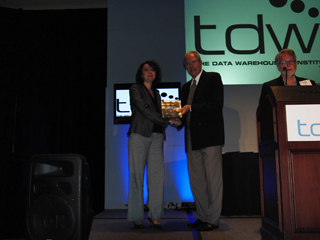
Category: BI on a Limited Budget
- Alcatel-Lucent
Alcatel-Lucent is a trusted partner of service providers, enterprises, and governments worldwide, providing solutions to deliver voice, data, and video communication services to end users. A leader in broadband networking and IP technologies, applications, and services, Alcatel-Lucent leverages the technical and scientific expertise of Bell Labs, one of the largest innovation powerhouses in the communications industry.
As the result of a company-wide reorganization in 2009, Applications Group’s BI platform had to be updated to support the business on a larger scale. The previous BI platform focused mainly on project management; the new platform had to offer a 360-degree view of the business. Alcatel-Lucent also wanted a user-centered, collaborative solution rather than a traditional BI platform in which users passively view reports and dashboards.
The organization’s BI solution, R&D 360, combines the latest open source technologies, Web 2.0 technologies, and BI best practices to monitor and control research and development activities. Leveraging BI, data warehousing, and data management technologies, R&D 360 provides up-to-date information and helps business users access and visualize near-real-time aggregated data buried in multiple operational systems—all in a single location.
R&D 360 supports Alcatel-Lucent’s processes and deployment of best practices. The solution helps solve business issues, provides monitoring gauges to the organization, and allows management to be proactive and make appropriate decisions based on consolidated and accurate data. It has helped the company save $500,000.
Alcatel-Lucent
Marc Lacaille, and Jean-Paul Saliou
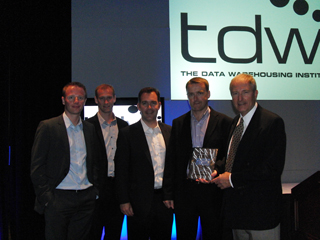
Category: Emerging Technologies and Methods
- GUESS? Inc. (co-winner)
GUESS?, Inc. is a well-known apparel company with more than 1,421 retail stores worldwide. A company known for its innovative style, GUESS continues to dress and accessorize the world with fashion-forward apparel, handbags, watches, shoes, and more.
Using emerging technologies in current mobile BI, GUESS?, Inc. created an innovative, next-generation BI iPad app that pushes actionable and mobile information to traditional and nontraditional BI users, allowing GUESS BI users to make better decisions. The content equivalent of 12 dashboards was turned into one multifaceted app to help merchants and executives be more productive during store visits, at corporate, or at home.
The app’s rich data and easy workflow allows it to serve multiple user communities, including executives, merchants, and designers. Users can tap a given style on their screens to open new screens with additional data, empowering decision makers with business-critical information whether they are traditional or nontraditional BI users. Because it is designed to encourage users to be inquisitive about the data, the app is transforming the BI culture of the company.
This latest cultural shift is revolutionizing how BI is utilized at GUESS by allowing users to explore business data without becoming technically overwhelmed as they navigate down and across to different levels of detail. The iPad app is easy to use, engaging, visually impactful, and business relevant with its embedded workflows.
GUESS? Inc.
Bruce Yen
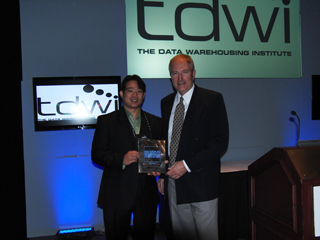
- Nykredit (co-winner)
Nykredit is one of Denmark's leading financial services groups involved in mortgage lending, banking, insurance, pensions, and estate agency businesses.
Nykredit’s project goal was to establish the technical framework to become an advanced credit institute under the Capital Requirements Directive (CRD) of Basel II. The company needed to develop risk assessment models that the Danish FSA would approve.
The Nykredit team developed a metadata framework that would define the behavior of the BI application and could be used actively in calculating all the measures and the generation of the actual reports for business users to view and approve before sending the finalized reports to the Danish FSA. Nykredit used the open source LAMP platform, with PHP as the programming language and an Oracle database to store the raw data, metadata, and resulting measures.
In November 2007, Nykredit obtained approval from the Danish FSA to apply the internal ratings-based approaches under Basel II. The framework’s first challenge came when the Danish FSA changed the majority of the report layout definitions and some of the formulas within a month of the first parallel reporting deadline. The changes were handled by only one worker in less than a week by simply verifying and changing metadata, proving that the metadata-driven framework is strongly adaptive, reusable, and easy to maintain and expand in a modular approach. It provides a competitive advantage: faster time to market and lower manpower requirements, and thus a high return on investment.
Nykredit
Frank Busborg and Ole Holm
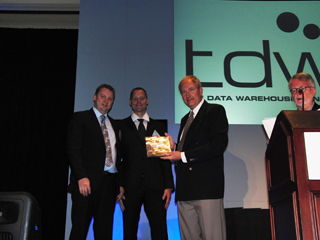
Category: Enterprise BI
- Westfield Insurance
Westfield Insurance is a 160-year-old provider of commercial and personal insurance and surety services via a network of 1,200 independent insurance agencies.
Westfield began its business intelligence program in 2007. It sought to attain customer intimacy to increase profitable growth and retention; develop insight into insurance risks, claims, agency/producer distribution, and customer satisfaction; drive product and service innovation using customer data; integrate and consolidate business and analytical intelligence processes across the enterprise; and drive common understanding and consistent usage of information.
The company adopted an iterative, sprint-based approach to report development. Reports were prototyped in joint application design (JAD) sessions with business analysts. Data governance was another key factor in delivering applications that meet the needs of different business units. The certification and publication of a BI data glossary resulted in a high degree of confidence in BI data quality and a high rate of adoption.
 Westfield established an Analytics Resource Center as a center of excellence for business analysts. It plays a critical role in establishing enterprisewide analytical priorities and translating business questions into meaningful metrics and dimensions. A dedicated change manager addressed the risks associated with the required cultural change, and “change agents” from each business unit helped manage the process for their areas.
Westfield established an Analytics Resource Center as a center of excellence for business analysts. It plays a critical role in establishing enterprisewide analytical priorities and translating business questions into meaningful metrics and dimensions. A dedicated change manager addressed the risks associated with the required cultural change, and “change agents” from each business unit helped manage the process for their areas.
These four elements—collaborative and iterative design; enterprisewide data governance; analyst center of excellence; and change management discipline—combined to create a broadly supported, integrated effort that drove successful adoption of BI at Westfield.
Westfield Insurance
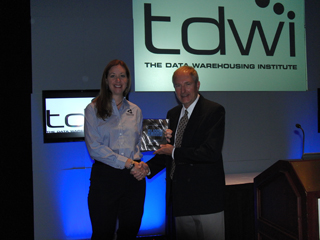
Category: Enterprise Data Management Strategies
- Quicken Loans Inc. (co-winner)
Quicken Loans is the nation’s largest online home mortgage lender and one of the 10 largest retail lenders in the country. The company is affiliated with sister companies in the title and real estate industries. Quicken Loans’ 7.5 TB data warehouse is focused on providing visibility to the constantly changing business. Vast amounts of operational data have made enterprise data management strategies necessary, including automation, optimizing visibility into data and processes, and database administration. The company’s real-time BI goals are driven by fluctuating interest rates, increased compliance, and banker-licensing requirements.
Over the years, Quicken has developed a solid architecture that has streamlined the way it integrates data from any source. It has identified the exact steps the data must go through. In addition, the rules and data-cleansing steps are coded into the templates for data warehouse population. In a data warehouse environment of this size, managing metadata is a necessity. Quicken has automated the collection of data regarding all database-related objects, including tables, views, columns, cube dimensions and measures, and stored procedures.
Quicken Loans’ successful implementation of a real-time EDW and ETL/OLAP architecture exemplifies a good foundation, and its tools show consistent innovation on the platform. The company’s bankers, directors, and marketing analysts understand and trust the information they view, which helps them make the best decisions and helps keep the company ahead of fluctuating capital markets and interest rates.
Quicken
Lisa Philip and Matt Lauer

- Thrivent Financial for Lutherans (co-winner)
Thrivent Financial for Lutherans is a faith-based, not-for-profit, Fortune 500 membership organization with nearly 2.5 million members and over $73 billion in assets. Thrivent Financial began to design and implement its enterprise information management strategy in 2007. The goal: to build a foundation of trusted, accessible, and documented data by leveraging existing data, complying with standards, and contributing to data sharing and reuse. The strategy covers data warehousing, business intelligence, data governance, master data management, data services, and enterprise content management.
The implementation of the strategy drastically changed the data approach from silo project-by-project development to a cohesive, enterprisewide approach. This enabled several key business initiatives, improved data quality and security, and yielded multimillion-dollar annual savings. Execution of the strategy supported business growth, reduced risk, and increased efficiency by providing common, unified, and trusted data to operational and analytical applications.
The subject area framework has gained widespread acceptance and is now used to provide a common framework and language across business and IT, establish clear boundaries of data ownership and stewardship, and identify common data needs across projects. It has also been employed by business users to communicate their data needs to IT.
Thrivent Financial created a unique approach that interconnects key data capabilities and is based on a common subject area framework adopted by business and IT. This approach is consistently implemented by all enterprise projects so that data solutions are aligned across the enterprise.
Category: Enterprise Data Warehousing
- WellPoint, Inc.
- Solution Sponsor: Cognizant Technology
WellPoint is the largest health benefits company in the U.S., with approximately 33.5 million members in its affiliated health plans. WellPoint offers a broad portfolio of integrated healthcare plans and related services, and specialty products such as life and disability insurance benefits; pharmacy, dental, and vision plans; and long-term care insurance. WellPoint wanted to establish a centralized, near-real-time enterprise data warehouse by integrating multiple sources of data into a single enterprisewide data model and promoting standardized platforms, tools, and definitions.
The initiative EDWard (enterprise data warehouse reporting depot) provides integrated healthcare information with latency of less than 24 hours from over 30 operational entities. In addition, it provides a high-end analytical data platform (with consolidated views of its 33.5 million members) to internal business entities and external partners, driving business initiatives that lower care costs and improve care quality. EDWard played the critical role of information backbone of several enterprisewide business initiatives at WellPoint, including standardizing health and wellness programs, an online tracking and self-serve incentives reporting solution, and reducing the cost of care programs.
After the implementation of EDWard, WellPoint is expected to retire about 20 information assets and realize significant cost savings by eliminating infrastructure and maintenance. The EDW also supports WellPoint’s compliance management processes and helps build beneficial partnerships with healthcare entities. Business departments within WellPoint consider EDWard a key strategic asset and adopted it in many business processes and programs.
Category: Government and Non-Profit
- Internal Revenue Service
The Internal Revenue Service (IRS) is responsible for collecting taxes, administering our nation’s tax laws, and providing service to taxpayers.
The IRS Compliance Data Warehouse (CDW) supports these efforts by providing data, tools, and computing services to research analysts in the IRS and Department of Treasury for statistical analysis, mathematical modeling, simulation, prediction, and other research activities aimed at improving tax administration. As the biggest database in the IRS, the CDW has set the standard for large-scale data analytics in the world’s largest tax agency. Brought online in 1997 with less than one terabyte (TB) of data and a handful of users, it has since grown into a nearly one petabyte (PB) system serving hundreds of analysts across multiple agencies.
The CDW manages a massive amount of data used to estimate the U.S. tax gap, develop models of taxpayer burden, simulate the effects of policy changes on taxpayer behavior, identify abusive tax schemes, and support other strategic initiatives. Over time, it has become the preferred system for both short- and long-term analytics, and is often the last resort when data does not exist in a usable format anywhere else.
The CDW has surpassed its goal of providing data to the IRS Research community. It now maintains over 15 years of data from more than 20 legacy sources and supports analysts in the Treasury Department, Joint Committee on Taxation (U.S. Congress), General Accountability Office, and the Treasury Inspector General for Tax Administration.
Category: Organizational Structures
- National Instruments Corporation
National Instruments, a leader in virtual instrumentation for 34 years, delivers LabVIEW graphical software and modular instrumentation hardware for product design, simulation, control, testing, and manufacturing. The Austin, Texas-based company has 5,200 employees worldwide, direct operations in over 40 countries; and $873 million in 2010 revenue.
National Instruments’ BI/DW program develops enhanced capabilities to meet the needs of global stakeholders, including increased self-service to integrated, actionable information that provides answers and insights to increasingly sophisticated business questions.
Since 2007, NI has adopted a new EDW architecture (with gradual retirement of its legacy architecture), implemented a new enterprise reporting platform, and adopted or improved critical processes.
NI employs a BI/DW virtual team model where three individual teams work in partnership. Each team has specific core competencies, career paths, and dedicated management. The three teams consist of BI program managers and analysts, DW business analysts, and DW programmer analysts. The virtual team organizational structure enables an agile, enterprise engagement framework, which produces an effective tool to identify and accomplish the needs of the business.
This organizational structure offers uncommon benefit and scale, as each of the three teams can focus resources to evolve their own departmental initiatives, proficiencies, and vision. No single team is responsible for enterprisewide information management. Instead, the BI team specializes in crafting strategic and tactical solutions for the business, while the business and programmer analyst departments specialize in implementation.
Category: Performance Management
- Cleveland Clinic
- Solution Sponsor: STS Consulting Group
Located in Cleveland, Ohio, the Cleveland Clinic is a not-for-profit, multi-specialty academic medical center that integrates clinical and hospital care with research and education. It employs 40,000 workers, including more than 2,800 physicians and scientists in 120 medical specialties and subspecialties in clinics around the world.
Cleveland Clinic developed a comprehensive strategy for an enterprise business intelligence (EBI) program to help it focus on defining, measuring, and improving the key performance indicators necessary to fulfill strategic performance management objectives. The EBI program addresses people, processes, governance, and technology as it improves decision making by using automated enterprise data warehouse information in fact-based analytics.
The company’s solution allows leaders to gain real-time views of actual performance and help focus scarce resources, accelerate change, and achieve performance management excellence. It enabled Cleveland Clinic to create a comprehensive set of management dashboards with timely information, adding quantifiable value in less than a year. The solution also helped Cleveland Clinic reduce costs and enhance quality of care, even during periods of national and local economic turmoil.
Cleveland Clinic’s enterprise performance management program demonstrates that comparisons between actual performance and strategic objectives can enable healthcare organizations to achieve rapid organizational change. This change has reduced costs, increased revenues, and improved the quality of patient care at Cleveland Clinic. Key lessons learned include the importance of executive championship, dedicated resources, openness to resolving data anomalies, clarity and appropriate communication, and scalable technology architecture.
Category: Right-Time BI
- Station Casinos, Inc.
- Solution Sponsor: Informatica Corporation
Founded in 1976 in Las Vegas, Nevada, Station Casinos provides gaming and entertainment for residents of the Las Vegas metropolitan area. Station's properties include hotels and restaurants, entertainment venues, movie theaters, bowling and convention/banquet space, and traditional casino gaming offerings.
Station Casinos wanted a better understanding of customer activities and preferences and the ability to offer personalized incentives to increase its customer base. Station Casinos undertook an initiative to gather data from its 18 resorts and casinos and provide a 360-degree, real-time view of customer activities. The data would include all customer “touch points,” including financial, gaming, hotel, food and beverage, and other data to understand customer trends, usage patterns, and the overall casino experience.
To get this level of detailed information, Station Casinos deployed the Informatica Platform, which provides the ability to access, clean, and deliver critical data in real time, including integrated customer, gaming, and finance information from as many as 500 heterogeneous sources and 9.2 million customer records.
The solution is fully operational and has achieved its goals using real-time data integration and analytics across numerous properties and venues and customer touch points to power more rewarding customer service and build customer loyalty. The project shows how it is possible to overcome hurdles to real-time BI such as massive numbers of siloed data sources, high volumes of rapid-fire database changes, and development of new services to enhance customer service and build customer loyalty.
Award winners were chosen by a panel of independent judges who have expertise in BI and DW. The panel of judges included: Barb Wixom, Associate Professor, University of Virginia; Chris Adamson, DW Specialist, Oakton Software LLC; Colin White, President & Founder, BI Research; Daniel R. Evans, CBIP, Sr. Group Manager/Solution Lead, Avanade, Inc; David Stodder, Director, TDWI Research; Evan Levy, Partner, Baseline Consulting; Hugh Watson, Professor of MIS, University of Georgia; Jill Dyché, CBIP, Partner, Baseline Consulting; John K. Thompson, CEO, Marketing Sciences, Inc.; Jonathan G. Geiger, CBIP, Executive Vice President, Intelligent Solutions, Inc.; Laura Reeves, Principal, StarSoft Solutions; Mark Madsen, President, Third Nature; Mark Peco, CBIP, Partner, InQvis; Nancy Williams, CBIP, Vice President, DecisionPath Consulting; Patty Haines, President, Chimney Rock Information Solutions; Philip Russom, Director of Research, TDWI; Ralph Hughes, Chief Systems Architect, Ceregenics, Inc.; Sid Adelman, Principal, Sid Adelman & Associates; Steve Dine, President, Datasource Consulting, LLC; and Steve Williams, President, DecisionPath Consulting.